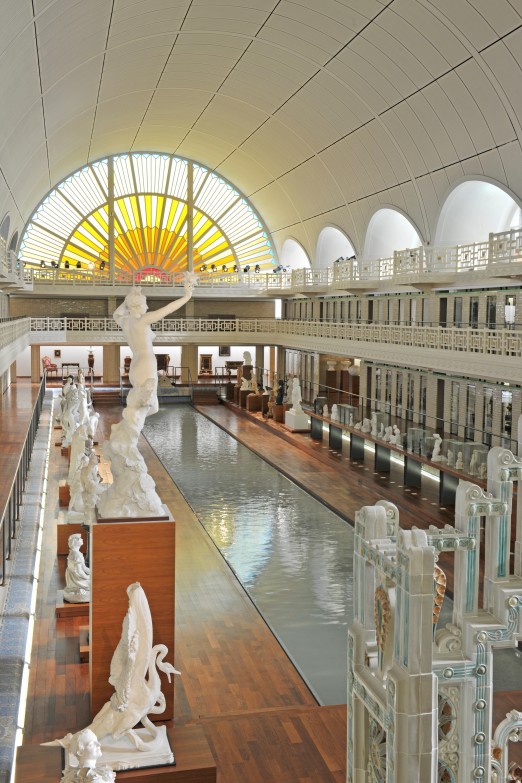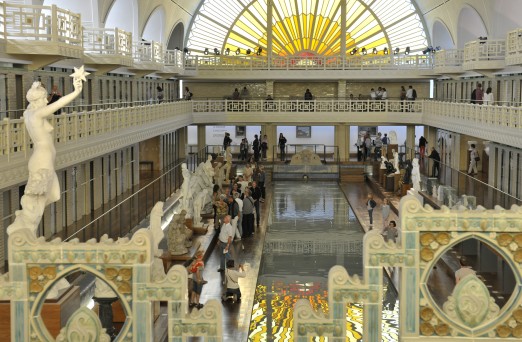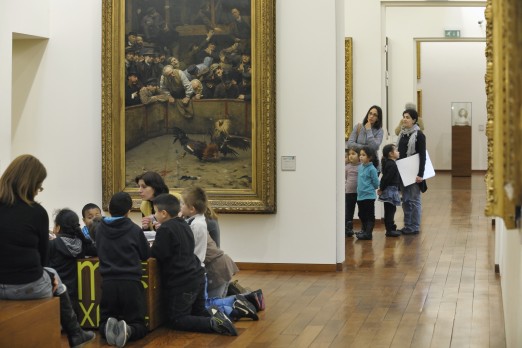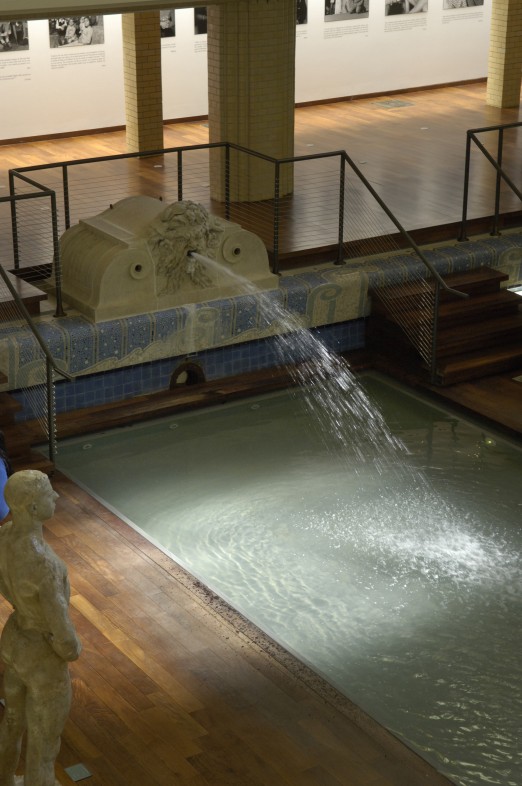History of the Museum
The history of the Roubaix museum collections is rich and complex, and explains the diversity of the collections presented today and the importance of the Roubaix collections.
From Industrial Museum to the National Roubaix Museum
The origin of La Piscine – the museum of art and industry dates back to 1835, the date of creation of the Roubaix industrial museum. At the time it presented, in large related works, significant samples of the city’s contemporary textile production. In 1861, thanks to a municipal agreement, the museum widened its scope of action to the Fine Arts which added to the rich textile collections. From 1882 to 1889, the city museum’s collections were transferred to the Ecole Nationale Supérieure des Arts et Industries Textiles (ENSAIT) – the National School for Textile Arts and Industries – for educational purposes to enhance training received by future textile engineers. The collections were under State control and the museum became the Roubaix National Museum. From 1902 onwards, the collections developed significantly largely in part to Victor Champier. The former director of the Revue des Arts Décoratifs, a decorative arts magazine, he worked to break down the boundary between the Fine Arts and the decorative arts and succeeded Verlais at the head of the school. He played a major role in the museum’s evolution: there were purchases of modern art (Lebourg, Martin, Désiré-Lucas), Sèvres ceramics from the Universal Exhibitions were awarded to the museum as a result of his people skills, and his reputation as an art critic promoted gifts (Galland in 1892, Roche, Lemaire).
In parallel, Henri Selosse, the Roubaix textile merchant, bequeathed his collection which represents an important part of the museum’s current collections. The gift was composed of paintings, drawings, sculptures, and art objects including several with important signatures (Ingres, Fantin-Latour, Lépine, Gérôme, Weeks, Loir, Cogghe, etc.).
With the museum, Champier sought to establish a permanent contact between works of art and textile technicians to promote the alliance between art and industry.
However, as with all the national museums, the Roubaix museum closed during the Second World War. The collections were considered old-fashioned, and the Roubaix Museum never reopened after the Liberation of France. It was decommissioned by the State and the collections were abandoned to Ensait.
A New Museum in Roubaix : The Weerts Museum
In 1924, the Roubaix painter Jean-Joseph Weerts (1846-1927), known for his social portraits and public paintings, donated his studio’s collection to Roubaix so as to create a monographic museum in the city of his birth. This municipal establishment was installed in the City Hall building. From 1963 to 1980, Marcel Guillemyn was the director of the museum. In the 1970s, he sought to change the museum’s vocation by incorporating several vestiges of the great museum of 1889, specifically the Selosse bequest and gathered documents relative to local history which were to serve as a base for a museum of art and popular traditions which never saw the light of day. In the early aughts, the Weerts museum closed down to general indifference. Nonetheless, Didier Schulmann succeeded Marcel Guillemyn as the head of the collections. He was the first professional curator of the Roubaix museum of art and industry.
The Progressive Birth of the Roubaix Museum of Art and Industry
Didier Schulmann drove the project for a museum in Roubaix which would bring the different collections together. Lacking a building to present the collections, only an events programme could be envisioned. The temporary exhibitions alternated with local subjects and wider ambitions, and for over a decade ensured the sustainability of a possible museum in Roubaix which was at the time reduced to the occasional occupation of multi-purpose rooms in the city hall building.
In 1988, the presentation of a work being acquired by the Louvre, marked a turning point in the museum’s history. The SARI real estate group were among the important subscribers assembled by the Louvre for the acquisition of Saint-Thomas by Georges de La Tour. As they were undertaking important real estate projects in Roubaix, SARI asked that the devasted city be one of the rare stops on the circuit organised for the painting which would then join the national heritage. And it’s in one of the abandoned galleries of the national museum which had been closed for half a century that Didier Schulmann organised the showing of Saint-Thomas with an exceptional presentation of emblematic works from the Roubaix collection, an indubitable discovery for the visitors and an extraordinary success. Roubaix revisited its museum and wheels started turning. The Piscine adventure could begin.
Different sites were suggested for the museum but no agreements were reached. In 1990, the municipal council approved the idea launched by a new museum curatorial team to transform the former swimming pool into a museum. A prefiguration room of the museum opened in City Hall so as to present, in rotation, the museum’s future collections.
Built in 1932, the pool on the rue des Champs had closed in 1985. The project was confirmed in July 1992, and a convention signed between the State and the City of Roubaix thus transferring the former national museum collections to the city of Roubaix. The museum would also receive important works stored in national museums specifically the Orsay Museum, the National Museum of Modern Art, and the National Contemporary Art Fund. La Piscine at long last opens its doors in October 2001.
A Much-Needed Expansion
After it reopened in October 2001, La Piscine met with remarkable media and public success. The Roubaix museum heritage was enriched with stored works, gifts, and purchases made by the city or with the help of La Piscine’s Friends of the Museum and the Circle of Business Patrons. To preserve and present these consequential ensembles of several thousand references, an expansion quickly became necessary. Winner of the contest launched in 2011, Jean-Paul Philippon once again was tasked with writing this new architectural page in the museum’s story.
After 18 months of works and a six-month closing in order to install the new presentations, La Piscine reopened on October 20, 2018. With an additional surface of over 2000 square metres, the new spaces dedicated to the History of Roubaix, sculpture, the Roubaix Group, temporary exhibitions, and young audiences adds historical wealth to the visitors’ pathway through the museum and the services offered.










